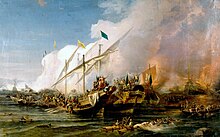Candia (ship, 1530)
|
||||||||||||||
|
||||||||||||||
|
||||||||||||||
|
||||||||||||||
The Candia was an early modern ship of the Republic of Venice , which can be classified as a galleon and was named after the city of Candia on the island of Crete (today's Heraklion ).
construction
The planks of the upper deck were covered with metal plates to offer protection to the soldiers on board. However, this metal planking brought a lot of weight to the ship at the expense of maneuverability. Because it had a fortress-like structure, the galleon was able to prove its superiority in the sea battle of Preveza against a majority of rowing galleys.
history
At the end of the summer of 1538, a fleet of 302 ships of the Holy League set sail from Venice, Genoa and the Papal States, to which the galleon Candia belonged. The fleet was under Andrea Doria , who was used by Emperor Charles V as an admiral. The captain of the Venetian flagship , which was the Candia , was the Venetian captain Alessandro Condalmiero . The mission of the allied squadron was to fight the Ottoman corsair Khair ad-Din Barbarossa , who carried out extremely successful raids in the Mediterranean. Barbarossa initially withdrew to the Ambracian Gulf and awaited the attack from Andrea Doria - but this did not materialize for tactical reasons. Instead, Doria withdrew with his fleet to the island of Lefkada and stayed there. Barbarossa was lured out into the open sea and took up the pursuit of the Allied squadron, so that it finally came to battle on September 28, 1538.
The Candia was destroyed by the first opposing volleys of the main mast - at the same time a lull set in. Thus, the fate was part of her that she had to remain alone in the catchment area of the Ottoman ships, while the rest of the fleet formed a little separated to the order of battle.
The incapable of maneuvering Candia was able to fend off several waves of attacking Ottoman oarlocks by captain Condalmiero let the enemy get very close and then fired broad sides at the enemy, who then suffered considerable damage and could no longer continue their attack. With this tactic, the Candia was actually able to survive the whole day and thus demonstrated its superiority over the rowing galleys. Although the Ottoman side had 400 dead and 800 injured, the battle for the Holy League was still lost because Doria spared the Genoese part of her own fleet and finally decided to flee - the remaining parts of the fleet succumbed to the Ottoman opponents.
Nevertheless, the course of the battle, in particular the defiance of the galleon Candia , influenced the future construction of ships and the approach to sea battles. Due to the - now proven - fortress-like structure of the ship, the maneuverability of a ship and boarding ability of the crew were no longer the decisive attributes for a successful sea combat, but resistance, such as armor, but above all the firepower of the guns.
literature
- Attilio Cucari: Sailing Ships - The Queens of the Seas - History and Typology . Bassermann, Munich 2008, ISBN 978-3809423461 (Italian original edition: Velieri . Mondadori Electra SpA, Milano 2004)
Footnotes
- ↑ There are some contradictions with regard to the name of the ship: Some other sources quote the name as Galeone Di Venezia , which, however, freely translated means nothing more than: “Venetian galleon” or “Galleon of Venice”. Since there were already several galleons in 1453 (see Siege of Constantinople in 1453 ) and Venice gained power and money through constant trade, but this influence can only be maintained with competitive ships, it can be assumed that 100 years later it was more than there was a single Venetian galleon - especially since this type of ship had already established itself at the time. The name Galeone Di Venezia can therefore only come from a translation error from available sources.
